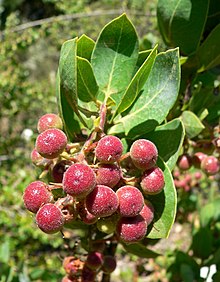Arctostaphylos glauca: Difference between revisions
Citation bot (talk | contribs) Add: s2cid. | Use this bot. Report bugs. | Suggested by Abductive | Category:Flora of Baja California | #UCB_Category 683/746 |
→External links: Jepson Link Updated |
||
| Line 31: | Line 31: | ||
==External links== |
==External links== |
||
*[ |
*[https://ucjeps.berkeley.edu/eflora/eflora_display.php?tid=13926 Jepson Manual Treatment - ''Arctostaphylos glauca''] |
||
*[http://plants.usda.gov/java/profile?symbol=ARGL4 USDA Plants Profile: Arctostaphylos glauca] |
*[http://plants.usda.gov/java/profile?symbol=ARGL4 USDA Plants Profile: Arctostaphylos glauca] |
||
*[http://calphotos.berkeley.edu/cgi/img_query?query_src=photos_index&where-taxon=Arctostaphylos+glauca ''Arctostaphylos glauca'' - Photo gallery] |
*[http://calphotos.berkeley.edu/cgi/img_query?query_src=photos_index&where-taxon=Arctostaphylos+glauca ''Arctostaphylos glauca'' - Photo gallery] |
||
Revision as of 14:21, 6 August 2023
| Arctostaphylos glauca | |
|---|---|

| |
| Scientific classification | |
| Kingdom: | Plantae |
| Clade: | Tracheophytes |
| Clade: | Angiosperms |
| Clade: | Eudicots |
| Clade: | Asterids |
| Order: | Ericales |
| Family: | Ericaceae |
| Genus: | Arctostaphylos |
| Species: | A. glauca
|
| Binomial name | |
| Arctostaphylos glauca | |
Arctostaphylos glauca is a species of manzanita known by the common name bigberry manzanita. It is native to California and Baja California, where it grows in the chaparral and woodland of coastal and inland hills.
Description
Arctostaphylos glauca is a large shrub varying in size from one to well over six meters in height. Individuals growing in desert regions tend to be shorter than those on the coast. Leaves are light gray-green, somewhat waxy, oval in shape to nearly round, and smooth or toothed along the edges. They are up to five centimeters long and four wide and grow on short petioles about a centimeter long.
The inflorescence holds hanging clusters of narrow urn-shaped white flowers. The edible fruit is a round or egg-shaped drupe 12 to 15 millimeters wide. It is light red in color and has a thick pulp covered in a tough, sticky coat. The fruit contains three to six nutlets fused into a single mass. The shrub reproduces by seed and by layering. Seeds require exposure to fire before they can germinate.
It is a long-lived species, reaching 100 years of age or more, though it does not begin to fruit until it is around 20 years old. The shrub is allelopathic, inhibiting the growth of other plants in its understory when rain leaches toxic arbutin and phenolic acids from its foliage.[2]
Uses
Despite their constipating effects, the fruits were eaten by the Native Americans of California, who also made the ripe fruit into a cider.[3]
See also
- California chaparral and woodlands
- California coastal sage and chaparral
- California montane chaparral and woodlands
References
- ^ Botanic Gardens Conservation International (BGCI) & IUCN SSC Global Tree Specialist Group (2019). "Arctostaphylos glauca". The IUCN Red List of Threatened Species. 208. IUCN. e.T144282654A149001453. doi:10.2305/IUCN.UK.2019-2.RLTS.T144282654A149001453.en. S2CID 242088102.
- ^ Ecology
- ^ Peattie, Donald Culross (1953). A Natural History of Western Trees. New York: Bonanza Books. p. 674.
External links
- Jepson Manual Treatment - Arctostaphylos glauca
- USDA Plants Profile: Arctostaphylos glauca
- Arctostaphylos glauca - Photo gallery
- IUCN Red List least concern species
- Arctostaphylos
- Flora of California
- Flora of Baja California
- Natural history of the California chaparral and woodlands
- Natural history of the California Coast Ranges
- Natural history of the Peninsular Ranges
- Natural history of the San Francisco Bay Area
- Natural history of the Transverse Ranges

